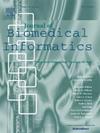GRU-TV:时间和速度感知门控复发单元的病人代表
IF 4.5
2区 医学
Q2 COMPUTER SCIENCE, INTERDISCIPLINARY APPLICATIONS
引用次数: 0
摘要
目的:从电子病历(EHRs)中提取多变量临床时间序列(MCTS)来表征动态生理过程。以前提出的深度患者表示模型是为了解决MCTS中的输入值和不规则采样问题。然而,生理状态的变化,特别是瞬时速度的变化,并没有得到足够的重视。方法:为了解决这一差距,我们提出了一个时间和速度感知门控复发单元(GRU-TV)模型,用于患者表征学习。在GRU-TV模型中,我们采用神经常微分方程来描述患者生理状态的瞬时速度。该瞬时速度被嵌入到GRU模型的隐藏状态更新过程中,以实现对不均匀时间间隔的感知。此外,GRU-TV模型的前向传播也包含了这种瞬时速度,从而能够感知患者生理状态随时间的非均匀变化。结果:GRU-TV模型的性能在两个真实世界数据集的多个临床问题上进行了评估。在完整、70%采样和50%采样的PhysioNet2012数据集上,子任务的平均AUC分别为0.89、0.84和0.83。在完整、20%采样和10%采样的MIMIC-III数据集上,急性护理表型分类的平均AUC分别为0.84、0.82和0.80。停留时间回归任务的平均绝对偏差为1.84天。结论:卓越的性能强调了瞬时生理变化在患者代表和临床决策中的重要性,特别是在具有挑战性的数据条件下。本文章由计算机程序翻译,如有差异,请以英文原文为准。

GRU-TV: Time- and Velocity-aware Gated Recurrent Unit for patient representation
Objective:
The multivariate clinical temporal series (MCTS) extracted from electronic health records (EHRs) can characterize the dynamic physiological processes. Previous deep patient representation models were proposed to address imputation values and irregular sampling in MCTS. However, the change in physiological status, particularly instantaneous velocity, has not received adequate attention.
Methods:
To address this gap, we propose a Time- and Velocity-aware Gated Recurrent Unit (GRU-TV) model for patient representation learning. In the GRU-TV model, we apply the neural ordinary differential equation to describe the instantaneous velocity of the patient’s physiological status. This instantaneous velocity is embedded in the hidden state updating process of the basic GRU model for the awareness of uneven time intervals. Besides, the forward propagation of the GRU-TV model also incorporates this instantaneous velocity to enable the perception of non-uniform changes in the patient’s physiological status over time.
Results:
The performance of the GRU-TV model is evaluated on multiple clinical concerns across two real-world datasets. The average AUC for the sub-tasks on the complete, 70% sampled, and 50% sampled PhysioNet2012 datasets are 0.89, 0.84, and 0.83, respectively. The average AUC for the acute care phenotype classification on the complete, 20% sampled, and 10% sampled MIMIC-III datasets are 0.84, 0.82, and 0.80, respectively. The mean absolute deviation of the length-of-stay regression task is 1.84 days.
Conclusion:
The superior performance underscores the importance of instantaneous physiological changes in patient representation and clinical decision-making, particularly under challenging data conditions.
求助全文
通过发布文献求助,成功后即可免费获取论文全文。
去求助
来源期刊

Journal of Biomedical Informatics
医学-计算机:跨学科应用
CiteScore
8.90
自引率
6.70%
发文量
243
审稿时长
32 days
期刊介绍:
The Journal of Biomedical Informatics reflects a commitment to high-quality original research papers, reviews, and commentaries in the area of biomedical informatics methodology. Although we publish articles motivated by applications in the biomedical sciences (for example, clinical medicine, health care, population health, and translational bioinformatics), the journal emphasizes reports of new methodologies and techniques that have general applicability and that form the basis for the evolving science of biomedical informatics. Articles on medical devices; evaluations of implemented systems (including clinical trials of information technologies); or papers that provide insight into a biological process, a specific disease, or treatment options would generally be more suitable for publication in other venues. Papers on applications of signal processing and image analysis are often more suitable for biomedical engineering journals or other informatics journals, although we do publish papers that emphasize the information management and knowledge representation/modeling issues that arise in the storage and use of biological signals and images. System descriptions are welcome if they illustrate and substantiate the underlying methodology that is the principal focus of the report and an effort is made to address the generalizability and/or range of application of that methodology. Note also that, given the international nature of JBI, papers that deal with specific languages other than English, or with country-specific health systems or approaches, are acceptable for JBI only if they offer generalizable lessons that are relevant to the broad JBI readership, regardless of their country, language, culture, or health system.
 求助内容:
求助内容: 应助结果提醒方式:
应助结果提醒方式:


